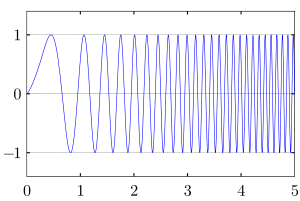- Chirp spread spectrum
-
In digital communications, Chirp spread spectrum (CSS) is a spread spectrum technique that uses wideband linear frequency modulated chirp pulses to encode information.[1] A chirp is a sinusoidal signal whose frequency increases or decreases over a certain amount of time. Below is an example of an upchirp—as you can see, the frequency increases linearly over time.
Contents
Overview
As with other spread spectrum methods, Chirp Spread Spectrum uses its entire allocated bandwidth to broadcast a signal, making it robust to channel noise. Further, because the chirps utilize a broad band of the spectrum, Chirp Spread Spectrum is also resistant to multi-path fading even when operating at very low power. However, it is unlike direct-sequence spread spectrum (DSSS) or frequency-hopping spread spectrum (FHSS) in that it does not add any pseudo-random elements to the signal to help distinguish it from noise on the channel, instead relying on the linear nature of the chirp pulse. Additionally, Chirp Spread Spectrum is resistant to the Doppler effect, which is typical in mobile radio applications.[2]
Uses
Chirp Spread Spectrum was originally designed to compete with ultra-wideband for precision ranging and low-rate wireless networks in the 2.45 GHz band. However, since the release of IEEE 802.15.4a (also known as IEEE 802.15.4a-2007), it is no longer actively being considered by the IEEE for standardization in the area of precision ranging. Currently, Nanotron Technologies, which produces real-time location devices and was the primary force behind getting CSS added to IEEE 802.15.4a, is the only seller of wireless devices using CSS[citation needed]. In particular, their primary product, the nanoLOC TRX transceiver, uses CSS and is marketed as a network device with real-time location and RFID abilities.[3] Some areas where this type of technology can be useful are medical applications, logistics (i.e. containers need to be tracked), and government/security applications. Nanotron even tested the TRX Transceiver for industrial monitoring and control in a steel mill and it survived when the computer and display that were interfacing with it failed because of the heat.[4]
Chirp Spread Spectrum is ideal for applications requiring low power usage and needing relatively low data rates (1 Mbit/s or less). In particular, IEEE 802.15.4a specifies CSS as a technique for use in Low-Rate Wireless Personal Area Networks (LR-WPAN). However, whereas IEEE 802.15.4-2006 standard specifies that WPANs encompass an area of 10 m or less, IEEE 802.15.4a-2007, specifies CSS as a physical layer to be used when longer ranges and devices moving at high speeds are part of your network. Nanotron's CSS implementation was actually seen to work at a range of 570 meters between devices.[5] Further, Nanotron's implementation can work at data rates of up to 2 Mbit/s - higher than specified in 802.15.4a.[6] Finally, the IEEE 802.15.4a PHY standard actually mixes CSS encoding techniques with Differential Phase Shift Keying Modulation (DPSK) to achieve better data rates.
Passband modulation Analog modulation AM · SSB · QAM · FM · PM · SM Digital modulation FSK · MFSK · ASK · OOK · PSK · QAM
MSK · CPM · PPM · TCM · SC-FDESpread spectrum CSS · DSSS · FHSS · THSS See also: Demodulation, modem,
line coding, PAM, PWM, PCMMultiplex
techniquesCircuit mode
(constant bandwidth)TDM · FDM · SDM
Polarization multiplexing
Spatial multiplexing (MIMO)Statistical multiplexing
(variable bandwidth)Packet mode · Dynamic TDM
FHSS · DSSS
OFDMA · SC-FDM · MC-SSRelated topics Channel access methods
Media Access Control (MAC)
Chirp Spread Spectrum may also be used in the future for military applications as it is very difficult to detect and intercept when operating at low power.[7]
See also
- Real time locating
- Zigbee
- Ultra-wideband
- Bluetooth
- Spectral efficiency comparison table
- IEEE 802.11
- IEEE 802.15.4
- IEEE 802.15.4a
- IEEE 802.16
- IEEE 802.20
- IEEE 802.22
References
- ^ IEEE Computer Society, (August 31, 2007). IEEE Standard 802.15.4a-2007. New York, NY: IEEE.
- ^ Berni, A. J., & Gregg, W. D. (June 1973). On the utility of chirp modulation for digital signaling, IEEE Transactions on Communications. Volume COM-21, 748-751.
- ^ Nanotron's nanoLOC TRX Transceiver, Nanotron marketing
- ^ [1], Nanotron Steel Mill Sensor Test: slide 20
- ^ [2], Nanotron Mine Test: slide 22
- ^ Nanotron Technologies, (2007). nanoNET chirp based wireless networks. Retrieved from http://www.nanotron.com/EN/docs/WP/WP_CSS.pdf
- ^ The Revenge of Chirp Spread Spectrum, Military applications
External links
- Download the 802.15 standards from IEEE
- IEEE 802.15 WPAN Low Rate Alternative PHY Task Group 4a (TG4a)
- Nanotron Technologies Frequently asked Questions page
- Nanotron Chirp Spread Spectrum page
- Nanotron nanoNET Chirp Based Wireless Networks
- about coexistence of IEEE 802.15.4aCSS with IEEE 802.11b/g (2.45GHz WLAN)
Spread spectrum in Digital Communications Main articles Spread spectrum Methods Direct-sequence spread spectrum (DSSS) · Frequency-hopping spread spectrum (FHSS) · Chirp spread spectrum (CSS) · Time-hopping spread spectrum (THSS)CDMA Schemes Major implementations Major concepts See also: Digital communication · Modulation · Statistical multiplexing · Waveform Categories:- Channel access methods
- Multiplexing
- Radio modulation modes
- Wireless locating
Wikimedia Foundation. 2010.

